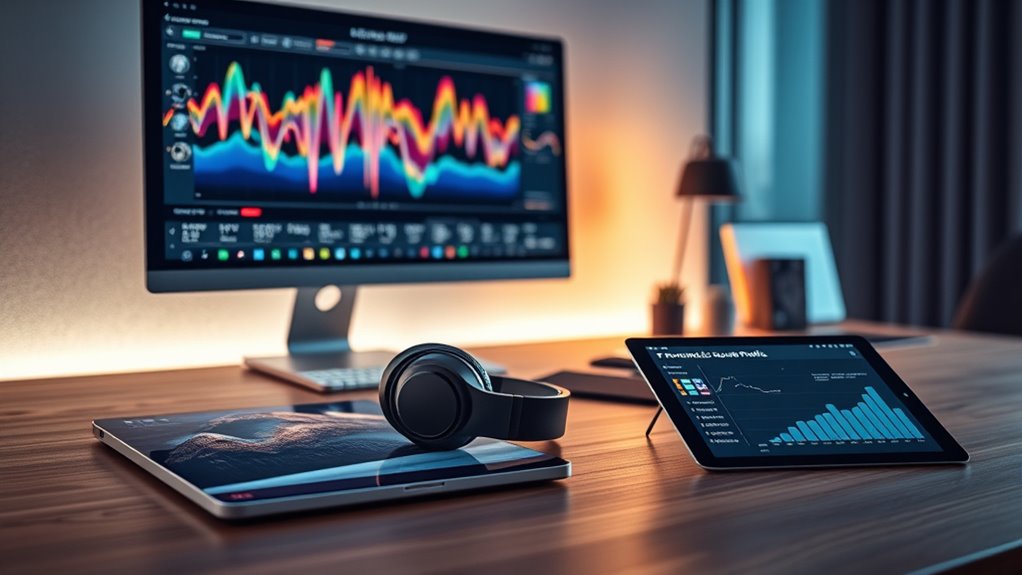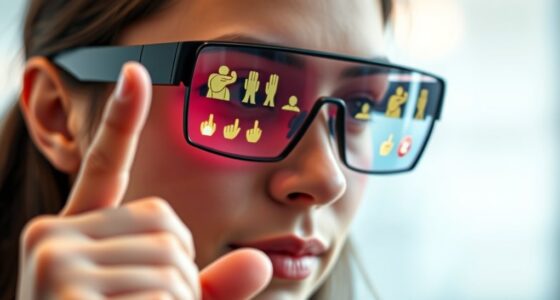Machine learning helps your audio devices learn your preferences and adapt to your environment automatically. By analyzing sound patterns, background noise, and speech, it creates personalized profiles that enhance clarity, filtering out unwanted sounds or boosting speech. These systems continuously improve as they gather more data, ensuring your sound experience stays tailored over time. Keep exploring how this technology shapes your everyday audio experiences and how it can become even more intuitive for you.
Key Takeaways
- Neural networks analyze individual user preferences and environment to tailor sound profiles for enhanced listening comfort.
- Machine learning models continuously adapt sound settings based on real-time user interactions and ambient noise changes.
- Personalized sound profiles are refined over time, improving clarity and noise suppression in diverse environments.
- Algorithms differentiate between speech, music, and background noise for targeted audio enhancements.
- Adaptive systems enable devices to deliver natural, customized audio experiences that evolve with user activity and surroundings.

Advancements in machine learning are transforming how we experience sound by enabling the creation of personalized sound profiles. These profiles tailor audio experiences to your unique preferences and hearing capabilities, making every sound more immersive and comfortable. At the heart of this revolution are neural networks, which are the backbone of many sound recognition systems. Neural networks process vast amounts of audio data, learning to identify specific sounds, voices, and environmental cues with remarkable accuracy. This ability allows devices to adapt in real-time, delivering sound tailored precisely to your needs. When you use a personalized sound profile, your device doesn’t just play generic audio; it recognizes the nuances of your environment and your preferences, adjusting volume, tone, and clarity accordingly. Sound recognition algorithms analyze patterns in ambient noise or speech, enabling your device to filter out distractions or enhance important sounds, such as speech in noisy settings. This technology is especially useful for hearing aids, earbuds, and smart speakers, where clarity and comfort are essential.
You become an active participant in shaping your audio environment. As neural networks learn from your interactions, they refine your sound profile, making it more accurate over time. For example, if you frequently listen to podcasts with background noise, your device can learn to suppress those sounds, providing a clearer listening experience. Conversely, if you prefer a richer bass or more treble, the system adapts to deliver audio that matches your taste. The process relies heavily on sound recognition techniques that distinguish between different sound sources and environmental conditions. These techniques allow your device to differentiate between speech, music, or background noise, applying the appropriate filters or enhancements. The more your device interacts with you, the better it becomes at predicting your preferences, creating a seamless and personalized audio experience.
In addition, understanding the environmental context enhances the effectiveness of sound recognition algorithms by providing relevant data for more accurate adjustments. This ongoing learning process highlights the dynamic nature of machine learning. Your sound profile isn’t static; it evolves as you change environments or preferences. The neural networks continuously analyze new data, ensuring your audio experience remains optimized. With these advancements, you’re no longer limited to generic audio solutions but can enjoy a tailored soundscape that adapts as you go about your day. Whether you’re working, relaxing, or exercising, your device leverages sound recognition and neural network capabilities to deliver sound that feels natural and effortless. This technology empowers you to control your auditory environment more intuitively, making every listening experience uniquely yours.
Frequently Asked Questions
How Secure Is User Data in Personalized Sound Profile Systems?
Your user data in personalized sound profile systems is generally secure if the company uses data encryption and safeguards storage. However, the security also depends on how well the company handles user consent and privacy policies. Always review privacy settings and opt for platforms that prioritize data protection. Being cautious about sharing sensitive information helps ensure your data remains safe and confidential.
Can Machine Learning Adapt to Rapid Changes in Hearing Preferences?
Yes, machine learning can adapt quickly to rapid changes in your hearing preferences. Adaptive algorithms track preference dynamics in real-time, allowing the system to adjust sound profiles seamlessly. This means you won’t have to manually recalibrate your settings constantly; instead, the system learns from your interactions and evolving preferences, ensuring a personalized experience that stays aligned with your needs, even as they change swiftly.
What Devices Are Compatible With Developing Personalized Sound Profiles?
You can develop personalized sound profiles with devices that support advanced sensor integration and flexible device compatibility. Smartphones, hearing aids, and smart earbuds often feature built-in sensors like microphones and accelerometers, enabling real-time data collection. Look for devices with open APIs or customizable software, as these facilitate seamless sensor integration and compatibility with machine learning algorithms, allowing you to fine-tune your sound experience based on your unique hearing preferences.
How Does Machine Learning Handle Diverse Hearing Impairments?
Think of machine learning as a skilled guide steering auditory diversity. It analyzes your unique hearing profile, adapting to various impairments through impairment customization. By recognizing subtle differences in sound perception, it fine-tunes audio output, ensuring clarity for diverse hearing needs. So, you get a personalized experience that respects your hearing journey, transforming complex data into a harmonious symphony tailored just for you.
Are There Privacy Concerns With Continuous Sound Data Collection?
Yes, there are privacy concerns with continuous sound data collection. You might worry about your data being misused or exposed. To address this, companies often use data anonymization techniques, removing personal identifiers to protect your privacy. Ethical considerations also play a role, ensuring data collection respects your rights and consent. Ultimately, transparency about data use helps build trust and safeguards your personal information while benefiting from personalized sound profiles.
Conclusion
By now, you’ve seen how machine learning shapes personalized sound profiles like a skilled artist crafting a unique masterpiece for each listener. With continuous data and smarter algorithms, your perfect soundscape is just around the corner. Think of it as tuning a musical instrument—fine-tuning until every note hits just right. Embrace this harmony of technology and your ears, and soon, you’ll experience sound tailored to your soul, turning every listen into a symphony made just for you.










